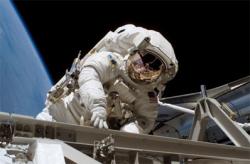Written by Fraser Cain

Well this news can't be good. While human bodies tend to get weaker during long duration spaceflight, dangerous microbes just get feistier, returning to Earth even more infectious. A colony of Salmonella typhimurium, the main culprit in food poisoning, flew aboard the space shuttle Atlantis last year. They came back three times more likely to cause disease when compared to control bacteria on the ground.
The discovery was made by researchers from Arizona State University's Biodesign Institute. Back in September 2006, they included a special experiment flown during the space shuttle Atlantis' mission STS-115. Don't worry, the bacteria were placed in three layers of containment to keep the crew safe. At the same time, a control experiment was maintained here on Earth.
The microbes were activated when they were pushed into a special growth chamber containing the nutrients they needed to multiply. They grew for 24 hours, and then astronaut Heidemarie M. Stefanyshyn-Piper pushed a plunger on the experiment that halted their growth, and preserved them. Another group of bacteria got fresh nutrients, so they could continue to grow and multiply.
Once the bacteria were returned to Earth, researchers measured the bacteria's gene and protein expression, and calculated their virulence. They found that the space traveling bacteria had changed expression of 167 genes. And they found that the bacteria was 3 times as likely to cause disease in animals (we probably don't want to know how they tested this) as the bacteria grown on the ground.
Why is this happening? The scientists aren't sure. They have ruled out the near zero-gravity, though. Their best explanation is a poorly understood phenomenon called fluid shear. This is the force of liquid passing over the cells. In microgravity, this fluid shear is very low, similar to the environment of the gastrointestinal track.
As frightening as this sounds, there should be a silver lining here. Salmonella is a particularly nasty strain of bacteria. Learning how it responded to spaceflight should give researchers valuable clues to how it grows and generates its dangerous toxin.
Original Source: ASU News Release



No comments:
Post a Comment